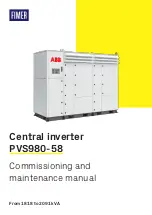
Vertiv™ NetSure™ IPE Series -48 VDC Outdoor Rectifier Installation and User Manual
Proprietary and Confidential © 2022 Vertiv Group Corp.
7
Figure 1.3 Power Derating Based on Temperature
6.
Regulation:
a)
Static: Steady state regulation is ±0.6% as controlled within the rectifier for any and all combinations of load from
5% to 100% load, input voltage, and input frequency at a constant ambient temperature.
b)
Dynamic: Response time ≤200 us and overshoot ≤5% for load changes at 50% - 25% - 50%
and 50% - 75% - 50% at rated output current.
For any step load change within the range of 10% to 90% of full load within 50 microseconds, per Telcordia
GR-947-CORE, the maximum voltage transient will not exceed 5% of the initial steady state voltage within 50±10
microseconds. Recovery to within 1% of the initial steady state voltage does not exceed 1 millisecond.
7.
Filtering:
a)
Voice Band Noise: Peak-peak voltage is ≤200 mV at 0 MHZ to 20 MHZ and normal output voltage.
b)
Wide Band Noise: Wideband noise voltage is ≤50 mV at 3.4 kHz to 150 kHz and ≤20 mV at 0.15 MHz to 30 MHz.
1.5.2
AC Input Ratings
1.
Voltage: Nominal 100 VAC to 250 VAC, 50 Hz / 60 Hz, with an operating range of 85 VAC to 300 VAC. The rated input
voltage is 220 VAC. Acceptable input frequency range is 45 Hz to 65 Hz.
Permitted Variation: 85 VAC to 300 VAC.
2.
Harmonic Content (THD): Meets EN61000-3-2. ≤5% from 50% to 100% of rated output current at 220 VAC to 240 VAC.
3.
Inrush Current: Peak does not exceed 1.5 times of the peak value of the maximum steady-state input current at full load.
4.
Typical Input Data: 50 Hz input.
a)
Refer to Table 1.8.
b)
Maximum Input Current: Refer to Table 1.9.
c)
Efficiency Curve: Refer to Figure 1.4.
5.
Typical Input Data: 60 Hz input.
a)
Refer to Table 1.10.
b)
Maximum Input Current: Refer to Table 1.11.
c)
Efficiency Curve: Refer to Figure 1.5.
















































